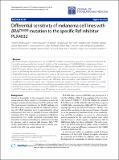Differential Sensitivity of Melanoma Cell Lines with BRAFV600E Mutation to the Specific Raf Inhibitor PLX4032

View/
Author
Søndergaard, Jonas N
Nazarian, Ramin
Guo, Deliang
Hsueh, Teli
Mok, Stephen
Sazegar, Hooman
Barretina, Jordi G
Kehoe, Sarah M
Attar, Narsis
von Euw, Erika
Zuckerman, Jonathan E
Chmielowski, Bartosz
Comin-Anduix, Begoña
Koya, Richard C
Mischel, Paul S
Lo, Roger S
Ribas, Antoni
Note: Order does not necessarily reflect citation order of authors.
Published Version
https://doi.org/10.1186/1479-5876-8-39Metadata
Show full item recordCitation
Søndergaard, Jonas N., Ramin Nazarian, Qi Wang, Deliang Guo, Teli Hsueh, Stephen Mok, Hooman Sazegar, et al. 2010. Differential sensitivity of melanoma cell lines with mutation to the specific Raf inhibitor PLX4032. Journal of Translational Medicine 8: 39.Abstract
Blocking oncogenic signaling induced by the BRAFV600E mutation is a promising approach for melanoma treatment. We tested the anti-tumor effects of a specific inhibitor of Raf protein kinases, PLX4032/RG7204, in melanoma cell lines. PLX4032 decreased signaling through the MAPK pathway only in cell lines with the BRAFV600E mutation. Seven out of 10 BRAFV600E mutant cell lines displayed sensitivity based on cell viability assays and three were resistant at concentrations up to 10 μM. Among the sensitive cell lines, four were highly sensitive with IC50 values below 1 μM, and three were moderately sensitive with IC50 values between 1 and 10 μM. There was evidence of MAPK pathway inhibition and cell cycle arrest in both sensitive and resistant cell lines. Genomic analysis by sequencing, genotyping of close to 400 oncogeninc mutations by mass spectrometry, and SNP arrays demonstrated no major differences in BRAF locus amplification or in other oncogenic events between sensitive and resistant cell lines. However, metabolic tracer uptake studies demonstrated that sensitive cell lines had a more profound inhibition of FDG uptake upon exposure to PLX4032 than resistant cell lines. In conclusion, BRAFV600E mutant melanoma cell lines displayed a range of sensitivities to PLX4032 and metabolic imaging using PET probes can be used to assess sensitivity.Other Sources
http://www.ncbi.nlm.nih.gov/pmc/articles/PMC2876068/pdf/Terms of Use
This article is made available under the terms and conditions applicable to Other Posted Material, as set forth at http://nrs.harvard.edu/urn-3:HUL.InstRepos:dash.current.terms-of-use#LAACitable link to this page
http://nrs.harvard.edu/urn-3:HUL.InstRepos:4706594
Collections
- HMS Scholarly Articles [17922]
Contact administrator regarding this item (to report mistakes or request changes)


